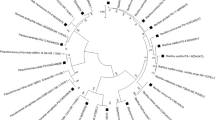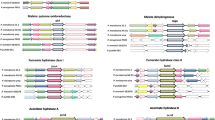Abstract
Different Frankia strains (HsIi2, HsIi4, HsIi5, HsIi8, HsIi9, HsIi10, HsIi11, HsIi12, HsIi13, HsIi14) nodulating Hippophae salicifolia D. Don, were characterized on the basis of physiological, biochemical and molecular attributes. Results suggest that the physiological approaches i.e., nitrogenase activity, glutamine synthetase (GS) activity and ammonia excretion are strain specific. The highest rate of nitrogen fixation and maximum production of ammonia with low GS makes the strain HsIi11, a suitable biofertilizer as compared to other strains. Analysis of total protein pattern (SDS–PAGE) revealed that the most closely related strains HsIi10 and HsIi4 were found to be most distantly related to the most similar strains HsIi14, HsIi5, HsIi13, HsIi11 and HsIi12. RAPD PCR analyses with an arbitrary primer 1253 produced distinct, unique and specific DNA fingerprints for each of the Frankia strain and 100% polymorphism was observed which uncovers the genetic diversity. These approaches might be helpful in rapid identification, in designing the marker for the specific strains as well as in improving nitrogen fixation in agroforestry.





Similar content being viewed by others
References
Baker DD, Mullin B (1994) Diversity of Frankia nodule endophytes of the actinorhizal shrub Ceanothus as assessed by RFLP patterns from single nodule lobes. Soil Biol Biochem 26:547–552
Benson DR, Hanna D (1983) Frankia diversity in an alder stands estimated by sodium dodecyl sulfate-polyacrylamide gel electrophoresis of whole cell proteins. Can J Bot 61:2919–2923
Benson DR, Silvester WB (1993) Biology of Frankia strains, actinomycete symbionts of actinorhizal plants. Microbiol Rev 57:293–319
Benson DR, Buchholz SE, Hana D (1984) Identification of Frankia strains by two-dimensional polyacrylamide gel electrophoresis. Appl Environ Microbiol 47:489–494
Boussiba S (1989) Ammonia uptake in the alkalophilic cyanobacterium Spirulina platensis. Plant Cell Physiol 30:303–308
Clawson ML, Caru M, Benson DR (1998) Diversity of Frankia strains in root nodules of plants from the families Elaeagnaceae and Rhamnaceae. Appl Environ Microbiol 64:3539–3543
Dobrista SV, Stupar OS (1989) Genetic heterogeneity among Frankia isolates from root nodules of individual actinorhizal plants. FEMS Microbiol Lett 58:287–292
Edmands J, Noridge NA, Benson DR (1987) The actinorhizal root nodule symbiont Frankia sp. strain CpI1 has two glutamine synthetases. Proc Natl Acad Sci USA 84:6126–6130
Fleming H, Haselkorn R (1973) Differentiation in Nostoc muscorum: nitrogenase is synthesized in heterocysts. Proc Natl Acad Sci USA 70:2727–2731
Flores E, Guerrero MC, Losade M (1980) Short term ammonium inhibition by nitrate utilization by Anacystis nidulans and other cyanobacteria. Arch Microbiol 128:137–144
Gomaa AM, Abo-Aba SEM, Awad NS (2008) Isolation, characterization and genetic differentiation of Frankia sp. isolated from ecologically different egyptian locations. Res J Cell Mol Biol 2:6–17
Gottlieb D, Hepden PM (1966) The electrophoretic movement of proteins from various Streptomyces species as a taxonomic criterion. J Gen Microbiol 44:95–104
Hein KT, Kerby NW, Machray GC, Rowell P, Stewart WDP (1988) Expression of glutamine synthetase in mutant strain of the cyanobacterium Anabaena variabilis which liberate ammonia. FEMS Microbiol Lett 56:337–342
Hill DJ (1977) The role of Anabaena in the Azolla anabaena symbiosis. New Phytol 78:611–616
Hirel B, Lea PJ (2001) Ammonia assimilation. In: Lea PJ, Morot-Gaudry J-F (eds) Plant nitrogen. Springer, Berlin
Kato K, Kanayama Y, Ohkawa W, Kanahama K (2007) Nitrogen fixation in seabuckthorn (Hippophae rhamnoides L.) root nodules and effect of nitrate on nitrogenase activity. J Jpn Soc Hort Sci 76:185–190
Khan A, Myrold DD, Misra AK (2009) Molecular diversity of Frankia root nodules of Hippophae salicifolia D.Don found in Sikkim. Ind J Microbiol 49:196–200
Lambein F, Wolk CP (1977) Structural studies on the glycolipids from the envelope of the heterocyst of Anabaena cylindrica. Biochemistry 12:791–798
Lowry OH, Rosebrough NJ, Farr AL, Randall RJ (1951) Protein measurement with Folin-phenol reagent. J Biol Chem 193:265–275
Lundberg P, Lundquist P-O (2004) Primary metabolism in N2-fixing Alnus incana-Frankia symbiotic root nodules studied with 15N and 31P nuclear magnetic resonance spectroscopy. Planta 219:661–672
Mahasneh TA, Mishra AK, Tiwari DN (1994) Transposon induced mutants of the cyanobacterium Anabaena sp. PCC7120 capable of ammonium liberation. Biotech Lett 16:765–770
Maniatis T, Fritsch EF, Sambrook J (1982) Molecular cloning. A laboratory manual, 1st edn. Cold spring Harbour Laboratory, New York
Mansour SR, Dewedar A, Torrey JG (1990) Isolation, culture and behaviour of Frankia strain HFPCg14 from root nodules of Casuarina glauca. Bot Gaz 151:490–496
Meeks JC, Wolk CP, Lockau W, Schilling N, Shaffer PW, Chien WS (1978) Pathways of assimilation of (13N), N2 and 13 NH4 + by cyanobacterium with and without heterocysts. J Bacterol 134:125–130
Mishra AK (2003) MSX-resistant mutants of Anabaena 7120 with depressed heterocyst development and nitrogen fixation. World J Microbiol Biotechnol 19:265–270
Murry MA, Fontaine MS, Torrey JD (1984) Oxygen protection of nitrogenase in Frankia sp. HFParI3. Arch Microbiol 139:162–166
Nierzwicki-Bauer SA, Haselkorn R (1986) Differences in mRNA levels in Anabaena living freely or in symbiotic association with azolla. EMBO J 5:29–35
Noel KD, Brill WJ (1980) Diversity and dynamics of indigenous Rhizobium japonicum populations. Appl Environ Microbiol 40:931–938
Noridge NA, Benson DR (1986) Isolation and nitrogen-fixing activity of Frankia sp. strain CpI1 vesicles. J Bact 166:301–305
Normand P, Orso S, Cournoyer B, Jeannin P, Chapelon C et al (1996) Molecular phylogeny of the genus Frankia and related genera and emendation of family Frankiaceae. Int J Syst Bacteriol 46:1–9
Postgate JR (1972) The acetylene reduction test for nitrogen fixation. In: Norris JR, Ribbons DW (eds) Methods in microbiology. Academic press, London
Prabina BJ, Kumar K, Kannaiyan S (2005) DNA amplification fingerprinting as a tool for checking genetic purity of strains in the cyanobacterial inoculum. World J Microbiol Biotechnol 21:629–634
Roberts MA, Crawford DL (2000) Use of randomly amplified polymorphic DNA as a means of developing genus- and strain—specific streptomyces DNA probes. Appl Env Microbiol 66:2555–2564
Rongsen LU (1992) Seabuckthorn: a multipurpose plant species for fragile mountains. In: ICIMOD publications (eds) ICIMOD, Nepal
Sarma HK, Sharma BK, Singh SS, Tiwari SC, Mishra AK (2006) Polymorphic distribution and phenotypic diversity of Frankia strains in nodule lobes of Hippophae salicifolia D. Don. Curr Sci 90:1516–1521
Sellstedt A, Wullings B, Nystrom U, Gustafson P (1992) Identification of Causarina-Frankia strains by use of polymerase chain reaction (PCR) with arbitrary primers. FEMS Microbiol Lett 93:1–6
Shapiro BM, Stadtman ER (1970) Glutamine synthetase (Escherichia coli). In: Tabor H, Tabor CW (eds) Methods in enzymology, pp 911–922
Singh A, Mishra AK, Singh SS, Sarma HK, Shukla E (2008) Influence of iron and chelator on siderophore production in Frankia strains nodulating Hippophae salicifolia D. Don. J Basic Microbiol 48:104–111
Singh A, Singh SS, Pandey PC, Mishra AK (2009) Attenuation of metal toxicity by frankial siderophores. Toxicol Environ Chem. doi:10.1080/02772240903449282
Solorzano L (1969) Determination of NH3 in natural waters by the phenol hypochlorite method. Limnol Oceanogr 14:799–801
Stewart WDP, Rodger A (1977) The cyanophyte-hepatic symbiosis II nitrogen fixation & interchange of nitrogen and carbon. New Phytol 78:459–471
Stewart WDP, Rowell P (1975) Effect of l-methionine-dl-sulphoximine on the assimilaton of newly fixed NH3, acetylene reduction and heterocyst production Anabaena cylindrica. Biochem Biophys Res Commun 65:846–856
Tabacchioni S, Visca P, Chiarini L, Bevivino A, Di Serio C et al (1995) Molecular characterization of rhizosphere and clinical isolates of Burkhlolderia cepacia. Res Microbiol 146:531–542
Torrey JG, Callaham D (1982) Structural features of the vesicle of Frankia sp. CpI1 in culture. Can J Microbiol 28:749–757
Tsai YL, Benson DR (1989) Physiological characteristics of glutamine synthetases I and II of Frankia sp. strain CpI1. Arch Microbiol 152:382–386
Welsh J, McClelland M (1990) Finger printing of genomes using PCR with arbitrary primers. Nucleic Acids Res 18:7213–7218
Acknowledgments
This work was supported by Department of Biotechnology, Government of India (BT/PR9145/AGR/21/233). We are also thankful to DST and CSIR, New Delhi for their financial assistance. The authors are grateful to Dr. S.C. Tiwari and Dr. Hridip Kumar Sarma for their valuable suggestions. The Head, Department of Botany, BHU, Varanasi, India is gratefully acknowledged for providing laboratory facilities. Department of Forest, Sikkim is also gratefully acknowledged for their help and support.
Author information
Authors and Affiliations
Corresponding author
Rights and permissions
About this article
Cite this article
Singh, S.S., Singh, A., Srivastava, A. et al. Characterization of frankial strains isolated from Hippophae salicifolia D. Don, based on physiological, SDS–PAGE of whole cell proteins and RAPD PCR analyses. World J Microbiol Biotechnol 26, 985–992 (2010). https://doi.org/10.1007/s11274-009-0260-7
Received:
Accepted:
Published:
Issue Date:
DOI: https://doi.org/10.1007/s11274-009-0260-7




